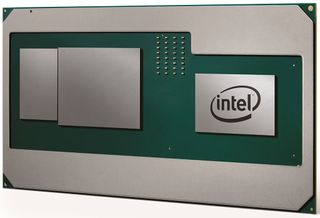Intel joins forces with AMD to battle Nvidia
A Core processor with custom Radeon graphics could be a game changer.

We checked the weather this morning and sure enough, Hell hasn't frozen over. Instead, something even less likely happened today—Intel announced it is working with rival AMD to build a new Core processor with custom Radeon graphics inside the chip package, with an emphasis on gaming performance.

The announcement between AMD and Intel today represents a significant change to PC gaming. We sat down with some of our hardware experts to get a technical take on how far reaching the impact is going to be.
Don't bother checking your calendar, we are still in November and this is not an April Fools' Day prank. After a report in The Wall Street Journal broke the news in the early hours of the morning, Intel posted an official announcement confirming the collaboration, and explaining its reasoning.
Looking at the current crop of gaming laptops on the market, Intel said it recognized an opportunity to build thinner, lighter, and more powerful enthusiast mobile platforms aimed at delivering a premium experience.
"Currently, most enthusiast mobile PCs have Intel Core H-series processors plus higher-powered discrete graphics, resulting in systems that average 26mm in height. Compare this to thin and light laptops that are trending down to 16mm or less, with some even as thin as 11 mm. We wanted to find a way to improve this," Intel said.
The new chip package will be part of Intel's 8th generation Core processor family and will combine a Core H-series CPU with second generation high bandwidth memory (HBM2) and custom discrete graphics from AMD. Intel says the silicon footprint of this new part will be less than half that of standard discrete graphics components on a motherboard, making it possible for OEMs to design thinner and lighter laptops without sacrificing performance.
Intel and AMD are thinking big there, with an eye toward triple-A gaming and content creation.
"Our collaboration with Intel expands the installed base for AMD Radeon GPUs and brings to market a differentiated solution for high-performance graphics," said Scott Herkelman, vice president and general manager, AMD Radeon Technologies Group. "Together we are offering gamers and content creators the opportunity to have a thinner-and-lighter PC capable of delivering discrete performance-tier graphics experiences in AAA games and content creation applications. This new semi-custom GPU puts the performance and capabilities of Radeon graphics into the hands of an expanded set of enthusiasts who want the best visual experience possible."
Comic deals, prizes and latest news
Sign up to get the best content of the week, and great gaming deals, as picked by the editors.

The idea came from Intel, which approached AMD about collaborating on a new chip, executives from both companies told PCWorld. At the outset, AMD is treating the Radeon core as a single-, semi-custom design similar to the custom graphics it supplies for game consoles like the Xbox One X and PlayStation 4.
Intel created a new connection for this project. At the heart of the design is an embedded multi-die interconnect bridge (EMIB), a small intelligent bridge that allows heterogeneous silicon to quickly pass information in close proximity. This is key in reducing the height requirements, and also cuts down on manufacturing and design complexities. Intel says this is the first product to take advantage of EMIB.
There is also a new power sharing framework that Intel designed for this project.
"We’ve added unique software drivers and interfaces to this semi-custom discrete GPU that coordinate information among all three elements of the platform. Not only does it help manage temperature, power delivery and performance state in real time, it also enables system designers to adjust the ratio of power sharing between the processor and graphics based on workloads and usages, like performance gaming," Intel explains.
Intel will work with AMD on drivers for the Radeon GPU, with AMD writing the initial code and Intel packaging them for users to download. The goal is to deliver driver updates for new games on the day they are released, or shortly before, just as AMD and Nvidia currently do with their gaming graphics products.
This collaboration brings up several questions that will be answered in time. One of them is what impact this will have on Intel's own integrated graphics, along with AMD's mobile APUs. It will also be interesting to see how this affects Nvidia. This is such big news that we've put together some additional thoughts on what this means for PC gaming.
Paul has been playing PC games and raking his knuckles on computer hardware since the Commodore 64. He does not have any tattoos, but thinks it would be cool to get one that reads LOAD"*",8,1. In his off time, he rides motorcycles and wrestles alligators (only one of those is true).
Most Popular




